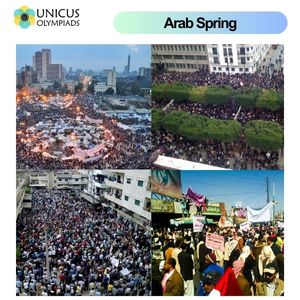What Was the Arab Spring, and How Did It Spark Political Change?
The Arab Spring was a series of anti-government protests, uprisings, and rebellions that swept across the Arab world starting in late 2010 and continuing into the next decade. The movement, initially sparked by widespread dissatisfaction with authoritarian regimes, corruption, and economic inequality, led to significant political change in many countries across the Middle East and North Africa. The Arab Spring began with the self-immolation of Mohamed Bouazizi, a Tunisian street vendor, but quickly spread to other countries, including Egypt, Libya, Syria, Yemen, and Bahrain. Though its outcomes varied widely, the Arab Spring left a lasting impact on the political landscape of the region. This article explores the origins of the Arab Spring, the countries involved, the political changes it sparked, and the long-term consequences of the movement.
1. Origins of the Arab Spring
The Arab Spring was not an isolated event; rather, it was the result of decades of political, social, and economic grievances that had been simmering in many Arab countries. Key factors that contributed to the Arab Spring included widespread corruption, human rights abuses, political repression, and economic challenges such as high unemployment, inflation, and rising food prices.

1.1 Economic Hardships and Political Repression
- High Unemployment: One of the most significant factors that fueled the Arab Spring was the high unemployment rate, particularly among young people in many Arab countries. In Tunisia, for example, more than 30% of youth were unemployed, creating a sense of frustration and hopelessness among a large portion of the population.
- Rising Food Prices: In many countries, soaring food prices led to widespread economic hardship. The cost of basic goods, including bread, became increasingly unaffordable for many people, contributing to the sense of economic injustice and inequality.
- Corruption and Authoritarianism: Many Arab leaders had been in power for decades, ruling with an iron fist and suppressing political opposition. Corruption was rampant, with leaders and their families often controlling key sectors of the economy. These authoritarian regimes were widely seen as illegitimate and unresponsive to the needs of their people.
1.2 The Trigger: Mohamed Bouazizi’s Self-Immolation
- The Catalyst: The Arab Spring is often traced back to the tragic event on December 17, 2010, when Mohamed Bouazizi, a 26-year-old Tunisian street vendor, set himself on fire in protest of police harassment and humiliation. Bouazizi’s act of self-immolation became a symbol of the widespread anger and despair felt by many in Tunisia and beyond.
- Spreading Anger: Bouazizi’s death ignited mass protests in Tunisia, calling for an end to the oppressive regime of President Zine El Abidine Ben Ali, who had been in power for over 23 years. The protests quickly grew into a larger movement that called for economic reforms, political freedom, and an end to corruption.
2. The Spread of the Arab Spring
The Tunisian revolution inspired similar movements in other Arab countries. Although each country’s experience during the Arab Spring was unique, the movement spread across the region, fueled by social media, increasing political awareness, and a shared desire for change.
2.1 Tunisia: The Beginning of the Arab Spring
- Success in Tunisia: Tunisia’s uprising was the most successful of the Arab Spring revolutions. Within a month of Bouazizi’s self-immolation, President Ben Ali was forced to flee to Saudi Arabia, marking the first time in the Arab world that an entrenched autocrat was ousted by popular protests. Tunisia then embarked on a process of political transition, drafting a new constitution and holding free elections in 2014.
- Impact on Other Countries: Tunisia’s success became a powerful symbol for other countries in the region. Social media played a crucial role in spreading the message of revolution and encouraging people in countries such as Egypt, Libya, and Syria to rise up against their own oppressive regimes.
2.2 Egypt: The Fall of Hosni Mubarak
- The 18-Day Revolution: Egypt’s revolution began in January 2011 with large-scale protests in Cairo’s Tahrir Square. Like Tunisia, the protests in Egypt were driven by frustration with political corruption, police brutality, and economic hardship. The movement quickly gained momentum, and after 18 days of mass protests, President Hosni Mubarak, who had ruled Egypt for nearly 30 years, was forced to resign on February 11, 2011.
- Aftermath and Military Control: After Mubarak’s resignation, the Egyptian military took control of the country, promising to oversee a transition to democracy. However, political instability persisted, and in 2013, the military ousted the elected president Mohamed Morsi, a member of the Muslim Brotherhood. The military-led government of General Abdel Fattah el-Sisi has remained in power since then, with significant repression of political opposition and civil liberties.

2.3 Libya: The Fall of Muammar Gaddafi
- Revolution and Civil War: In Libya, the Arab Spring quickly escalated into armed conflict. Mass protests against the 42-year rule of Muammar Gaddafi began in February 2011, and within weeks, the situation evolved into a civil war. Gaddafi’s forces used brutal tactics to suppress the uprising, but the revolutionaries received military support from NATO, which launched airstrikes against Gaddafi’s forces.
- Gaddafi’s Death: By October 2011, the revolutionaries had captured and killed Muammar Gaddafi, bringing an end to his regime. However, the overthrow of Gaddafi left Libya in a state of chaos, with competing factions vying for control of the country. Libya remains divided and unstable, with ongoing civil war and the presence of extremist groups like ISIS.

2.4 Syria: The Ongoing Civil War
- Initial Protests and Escalation: In Syria, the Arab Spring began with protests against President Bashar al-Assad’s regime in March 2011. However, unlike other countries, the Syrian government responded with violent repression, which escalated into a full-scale civil war. Over time, the conflict became more complicated, with multiple factions involved, including government forces, opposition groups, Kurdish militias, and extremist groups like ISIS.
- Regional and Global Involvement: The Syrian Civil War attracted international involvement, with Russia and Iran supporting Assad’s regime, while the United States, Turkey, and various Arab countries supported opposition groups. The war has resulted in hundreds of thousands of deaths, millions of displaced persons, and widespread devastation across the country.
2.5 Yemen and Bahrain: Struggles for Change
- Yemen: In Yemen, protests began in early 2011, leading to the eventual resignation of President Ali Abdullah Saleh after 33 years in power. However, the country soon descended into a civil war between the Houthi rebels, backed by Iran, and the government, supported by a Saudi-led coalition. The conflict in Yemen has resulted in one of the world’s worst humanitarian crises.
- Bahrain: In Bahrain, protests in 2011 called for political reform and an end to the monarchy’s authoritarian rule. The government, backed by Saudi Arabia, responded with force, and the protests were eventually suppressed. Bahrain remains an absolute monarchy with limited political freedoms.
3. The Role of Social Media in the Arab Spring
Social media played a crucial role in the Arab Spring, providing activists with a platform to organize, mobilize, and share information. It allowed for rapid communication and the sharing of images, videos, and personal testimonies of the protests and government repression, which helped galvanize international support.
3.1 Mobilization and Coordination
- Facebook and Twitter: Platforms like Facebook and Twitter were used to organize protests, spread awareness, and connect activists across different countries. Hashtags like #Jan25 (for the Egyptian revolution) became rallying cries for demonstrators. Social media bypassed state-controlled media, allowing activists to share uncensored information with the world.
- Citizen Journalism: Social media enabled ordinary citizens to become “citizen journalists,” documenting protests, government crackdowns, and human rights violations. This played a crucial role in breaking the state’s monopoly on information and garnering international attention to the uprisings.
4. Outcomes of the Arab Spring
The Arab Spring had mixed outcomes, with some countries experiencing political change, while others descended into chaos. While the movement inspired hope for democracy and freedom, it also led to unintended consequences in many regions.
4.1 Successes: Tunisia’s Democratic Transition
- Tunisia: Tunisia is often considered the success story of the Arab Spring. After the fall of President Ben Ali, Tunisia adopted a new democratic constitution in 2014 and held free and fair elections. Despite challenges, including political violence and economic instability, Tunisia remains the most stable democracy in the Arab world.
4.2 Failures and Ongoing Conflicts
- Egypt: While the Egyptian revolution led to the removal of Hosni Mubarak, the subsequent military takeover and the rise of authoritarian rule under President Abdel Fattah el-Sisi have shown the limits of the revolution’s success. The country remains politically repressive, with limited freedoms.
- Libya and Syria: In Libya and Syria, the Arab Spring led to prolonged conflict, instability, and humanitarian crises. In Libya, the overthrow of Gaddafi led to a failed state, while Syria remains embroiled in a devastating civil war.
- Other Nations: In other countries like Yemen and Bahrain, the Arab Spring led to unrest but failed to achieve lasting political change. In some cases, the initial protests were suppressed, and authoritarian regimes continued to dominate.
5. Long-Term Consequences and Lessons from the Arab Spring
- Global Awareness of Authoritarianism: The Arab Spring drew global attention to the oppressive nature of many Middle Eastern regimes. It also highlighted the importance of democratic values and human rights in the region.
- Impact on Western Foreign Policy: The Arab Spring led to a reassessment of Western foreign policy, especially the US and EU’s support for authoritarian regimes. The uprisings forced international actors to reconsider their relationships with countries like Egypt, Bahrain, and Saudi Arabia.
- The Challenge of Nation-Building: The Arab Spring revealed the complexities of nation-building, particularly in regions with deep ethnic, sectarian, and political divisions. The failure to establish stable, democratic governments in many countries has shown that revolutionary movements require more than just the overthrow of authoritarian regimes.
Conclusion
The Arab Spring was a defining moment in the modern history of the Arab world. It demonstrated the power of the people to challenge entrenched regimes and demand political change. While the movement led to significant political changes in some countries, it also exposed the deep challenges of democratization in the region. The Arab Spring left behind a legacy of both hope and disappointment, with some nations making strides toward democracy while others remain mired in conflict and authoritarianism. The impact of the Arab Spring continues to shape the political and social landscape of the Middle East and North Africa today.




